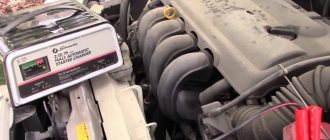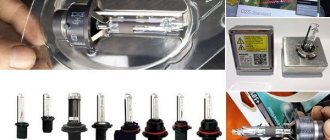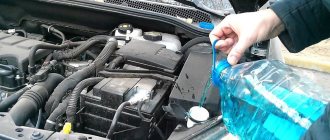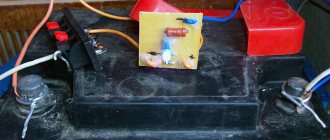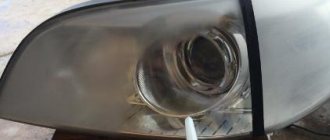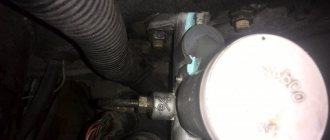For any car, one of the main elements of the mechanism is the battery. Currently, purchasing a power source of various models and designs is not difficult. However, there is a risk of buying a fake or faulty element; to do this, you need to know what parameters and using what methods you can check the battery.
Visual inspection
While in the store before purchasing, you need to check the new battery. First of all, you should visually inspect the power source. Even a novice car enthusiast can handle it quite well.
There are several main factors that you need to pay attention to before purchasing a battery:
- Presence of dirt on the terminals. The uninterrupted operation of any battery depends on normal and high-quality contact of the conductor with the battery terminals. The presence of dirt may mean that this is not a new power source.
- The presence of plaque on the terminals, mostly white, indicates that there is an electrolyte leak. Contact with an aggressive environment can damage it and reduce overall conductivity.
- Damage to the body. Upon external inspection, you can easily find cracks and chips on the power source. A new battery should not have such defects.
- There should be no leaks of acid electrolyte on the battery case, plugs or terminals. A drop in level can lead to premature failure of the plates.
How to visually check the battery
Inspect the battery case for case cracks and electrolyte leaks. Cracks can occur in winter if the battery is poorly secured and has a fragile plastic case. When working on a battery, moisture, dirt, evaporation or electrolyte drips accumulate, which, together with oxidized terminals, contributes to self-discharge. You can check if you connect one voltage probe and run the second one along the surface of the battery. The device will show what self-discharge voltage is available on a particular battery.
Electrolyte leaks can be eliminated with an alkaline solution (a teaspoon of soda per glass of water). And the terminals are cleaned with sandpaper.
Car battery polarity
Any battery must be checked for correct polarity upon purchase. Before removing the old power source from the car, you should note what polarity it had, it is indicated on the case.
If the positive terminal is on the right, then we have a power source with reverse polarity; almost all foreign batteries have this polarity. When the positive terminal is located on the left, it is straight polarity.
Attention! If the wrong polarity is selected during startup, a short circuit may occur in the battery or the on-board equipment may fail.
How to care for your battery
To avoid unnecessary troubles, you should regularly check the battery and give it the necessary care. To do this, the battery and its terminals must be kept clean and discharged/charged during prolonged inactivity. In severe frosts, it is better to take the battery from under the hood to a warmer place. Some manufacturers recommend charging the battery once every 1-2 weeks, arguing that sometimes the consumption exceeds the self-charging of the battery. Thus, checking the battery is a completely feasible task and necessary for the proper operation of the car.
Sources: etlib.ru, avtocod.ru
Date of manufacture
One of the important indicators of the battery condition is the production time. Over time, the internal capacity of the battery may gradually decrease. When the power source is not connected, the requirements specified in the operating and storage instructions must be observed. A situation may occur where the self-discharge exceeds the permissible values. If it has been stored for a significant period of time, then upon purchase you should check its internal capacity and operating voltage. The date of manufacture can be found in the device passport.
Important! It is recommended to purchase a power source that has been stored for no more than six months.
We buy batteries at the Malinovka car market and other retail outlets in Minsk
The first frosts, which mark the beginning of the winter period of operation, thoroughly test car batteries for their ability to supply the starter with the energy necessary to reliably start the engine. If the battery has served for at least four to five years, it is not a fact that it will successfully cope with the task, and when the service life is even longer, the chances that the battery will fail the exam become much higher.
The problem is that in cold weather, the aging processes that irreversibly occur inside the battery, which, by the way, can also be accelerated by the owners’ negligence in caring for the source of electricity, are superimposed by a deterioration in the battery’s characteristics associated with low temperatures and an increase in the resistance of the cold electrolyte. As a result, the battery ceases to cope with the duties that were performed effortlessly in the summer. This explains why the beginning of winter sees a surge in demand for batteries.
To find out what customers who urgently needed a “box with electricity” can count on, we visited the Malinovka car market and some other retail outlets in Minsk.
Let's say right away: the choice is huge everywhere we were. It is especially wide among batteries, which, according to their main characteristics, are most suitable for installation on car models common in Belarus.
From questioning sellers, it turned out that for most buyers the main characteristic is battery capacity. This is a really important parameter, which determines how many attempts you can make to start the engine before the battery is depleted to the limit.
Buyers pay less attention to another important characteristic—inrush current. Meanwhile, the higher the starting current, the more force the starter cranks the crankshaft when starting, which means you can hope for a more confident start of the engine. However, the magnitude of the starting current for diesel engines is important. Therefore, owners of diesel cars are mainly interested in starting current. Owners of gasoline cars are not very concerned about the starting current, which, apparently, reduces the number of buyers who, in addition to capacity, are also curious about this parameter.
However, some buyers go to the car market without any idea of the capacity and starting current that the battery they are looking for should have. The hope is that the sellers will tell you what kind of battery the buyer needs based on the car make, type and engine size.
But sellers are also different. Even retail outlets that specialize in selling batteries and have catalogs that list battery characteristics recommended for specific car models have had their share of incidents. In one of them, when making such a selection, I was advised to buy a battery with a capacity of at least 95 ampere-hours, although a “sixty-five” has been working properly in the car for five years, and the size of the battery recommended by the seller simply would not fit into the place intended for it.
But we must give the seller his due. Scratching his head, he put his catalog aside and said: no, something is wrong here. After that, calling on experience to help, he advised me to buy something with a capacity of about 70 ampere-hours and a starting current of about 600 amperes, which was actually close to what was required. In this case, what can be expected from sellers who do not specialize in batteries, but have only decided to expand their range for the winter season and extract additional benefits at the peak of demand?
In this regard, we would recommend going to the car market knowing not only the required capacity and starting current, which you can find out about either in the operating instructions or simply by looking at what these parameters are for the battery for which you are looking for a replacement, if it worked without bitch without a hitch. It also doesn’t hurt to first measure the overall dimensions of the old battery, and in addition, remember which side the positive and negative terminals are on, whether they are recessed in relation to the cover or protrude above it.
The capacity and starting current must be indicated on the labels affixed to the battery. Why you need to know the sizes is understandable.
As for the location of the terminals, there are European and Asian, according to sellers’ terminology, polarity. With European polarity, the positive terminal is always located on the right side, with Asian polarity - on the contrary. It should be borne in mind that the front side of the battery is usually facing towards the car’s interior, if you look at the battery with the hood of the engine compartment open. An error with the choice of polarity may result in the positive wire not reaching the positive terminal.
Whether the terminals are recessed in relation to the battery cover or protrude above it matters if some kind of device is provided to secure the wire to the terminal. In this case, with recessed terminals, it may be impossible to connect the wire to the terminal.
What all sellers have in common is the desire to sell a product that costs more. No matter who we approached, the very first ones offered were brand-name batteries. This was motivated by the fact that such batteries last five to six years or even more without problems, so the money paid for them will not be spent in vain. We argued that we weren't going to drive the car that much and didn't want to give it as a gift to the next owner. This caused despondency among sellers, but not for long, because in any specialized retail outlet there will always be goods not only of the highest, but also of any other price category.
The brand is the main thing that puts a battery into a particular price category. The value of the capacity and starting current has a significant impact on the cost, and whether the battery in question is serviceable, low-maintenance or maintenance-free. You can find out how much money you should take on a trip to the car market from the table.
| Estimated cost of some battery models | |||
| Model | Capacity, Ah | Starting current, A | Price, USD |
| Eurostart Extra Power | 55 | 430 | 60-64 |
| Zubr Ultra | 55 | 460 | 65-67 |
| Hagen Standard | 55 | 460 | 66-68 |
| Galaxy Hybrid | 55 | 550 | 72-75 |
| ZAP Plus | 55 | 460 | 78-82 |
| Topla | 55 | 480 | 88-92 |
| Centra Standard | 55 | 460 | 88-92 |
| Eurostart Extra Power | 60 | 480 | 67-70 |
| Zubr Ultra | 60 | 500 | 68-72 |
| Hagen Standard | 60 | 500 | 69-73 |
| Galaxy Hybrid | 60 | 570 | 78-82 |
| AAA Pronta | 60 | 600 | 90-94 |
| Topla | 60 | 600 | 91-95 |
| Varta Blue Dynamic | 60 | 540 | 120-125 |
| ZAP Silver Premium | 62 | 620 | 94-98 |
| Zubr Ultra | 66 | 640 | 84-88 |
| Black Storm | 70 | 570 | 84-88 |
| AAA Liner | 70 | 540 | 99-103 |
| Varta Blue Dynamic | 70 | 630 | 140-145 |
| Hagen Standard | 74 | 680 | 88-92 |
| Eurostart Extra Power | 75 | 615 | 86-90 |
| Volat Ultra | 75 | 780 | 99-103 |
| ZAP Plus | 75 | 720 | 107-110 |
| Topla | 75 | 750 | 120-125 |
Is Malinovka the final authority on prices? Hardly. In retail outlets in Minsk far from this car market, we found batteries of the same models that were offered at Malinovka, at a more attractive price, although we must admit that the difference was small.
Expert commentary
Viktor Shumsky, :
— Any buyer would certainly like to know what he is buying. The condition of the battery can be judged by the density of the electrolyte and the readings of the load plug. None of the sellers will open the battery to check the density, and in maintenance-free batteries this is not at all possible. But the load fork should be available from any qualified dealer. When testing with a plug, first measure the voltage at the terminals without load. It should be at least 12.5 volts.
Then they turn on the load and for a certain time, approximately corresponding to the duration of the start, and as you know, you can’t run the starter indefinitely, because it will burn out, watch how the voltage drops. To put it simply, a launch is simulated using a load fork. The load acts as a starter. If the voltage does not drop below 11 volts under load, it is a good battery.
It also makes sense to pay attention to the release date. Unfortunately, there is no single standard that would require manufacturers to be consistent in what this date should look like. Therefore, although it should be present on the battery, it is applied in different ways. Sometimes it is encrypted in markings in such a way that it is difficult for the average consumer to understand which few numbers among many others are the release date. Sometimes these are color dots.
Sometimes the date is indicated on the label, but it may turn out that there is a label, but there is no date on it. And the label, for that matter, is not difficult to re-stick. Sometimes misunderstandings arise because it happens that the buyer finds the date on the bottom of the case. It has nothing to do with the battery at all - it is the date of manufacture of the case. The case may be lying around in a warehouse. And the battery is considered released not when its case was made, but when electrolyte was poured into it. So, for myself, I would be careful not to buy a battery that has been standing somewhere on a display case for more than a year. Of course, the seller, who understands what a long downtime means for the battery, could recharge it during this period and thereby avoid negative consequences, but no one knows for sure whether this happened or not.
Sergey BOYARSKIKH Photo by ABW.BY
Large selection of new batteries for any car on the BAMPER.BY .
Look for spare parts correctly!
Indicator check
Some maintenance-free battery models have a special indicator, based on the color state, which can be used to judge some of the properties of the power source. The indicator during operation indicates three main states:
- green will show that the charge and electrolyte level are normal;
- black (red) indicates low battery;
- white indicates a drop in the electrolyte level below critical, there is practically no charge.
Accordingly, taking into account the shades of the battery indicator, you should carry out restoration manipulations with it, add electrolyte and charge it.
Manufacturers consider the disadvantage of this method to be that the device’s sensors are connected to only one can. Moreover, their price is significantly higher than that of the serviced ones, and during operation they require a powerful generator in good condition.
How to check if the battery is alive in a car without instruments?
It is quite easy to determine the condition of the battery in a car without special instruments. There are several ways to do this.
Modern batteries have a special charging indicator, usually in the form of a round window. You can determine the charge by the color of this indicator. Next to such an indicator on the battery there is always a decoding indicating which color corresponds to a particular charge level. Green - full charge; gray - half charge; red or black - full discharge.
In the absence of such an indicator, you can use two methods. The first is using headlights. The cooled engine is started and the low beam is turned on. If the light does not dim during 5 minutes of operation, then everything is normal.
The second (also when cold) is to turn on the ignition, wait a minute, and then press the signal several times. With a “live” battery, the beep sound will be loud and continuous.
Multimeter and load fork
A multimeter is a device that combines three main measuring devices:
- ammeter;
- voltmeter;
- ohmmeter
A digital device is best suited for checking the values of the power supply parameters. When measuring, you must follow the instructions:
- Remove the battery terminals from the covers, if any.
- Clean the contacts from dirt and oxides.
- Connect the red wire of the device to the positive electrode.
- The black wire must be connected to the negative terminal.
- Set the switch to the position for measuring DC voltage.
- A measurement is made. A normally charged battery should show a voltage of at least 12.4 V. If the value drops below the minimum allowable value, the battery is discharged.
- A reading of 12.9 V indicates that an overcharge has occurred.
- After checking, the covers are reinstalled on the terminals.
The load fork is a special device that shows the battery voltage value in a mode similar to its normal operation. This method will allow you to obtain complete data on the performance of the power source.
Interesting to know! Testing with a load fork is recommended to be carried out by specially trained personnel, however, if necessary, it can be assembled and measured at home.
When measuring with a load fork, the following recommendations must be observed:
- Free and clean the terminals from dirt and oxides, as well as factory lubricant residues.
- Connect the positive wire to the cathode.
- Connect the negative terminal to the anode.
- Touch the positive terminal of the battery with the pin. In this case, it is necessary to comply with safety requirements; the pin may heat up.
- A test is carried out; a charged power supply will display a value of 12.7 V.
https://www.youtube.com/watch?v=vl2Argm-fHQ
Battery current leak
If you leave your car in the parking lot in the morning or after a few days you cannot start it because the battery is dead, then there are a couple of reasons. One of them is an old battery. Second, increased current consumption by the electrical system.
This refers to how much various car systems consume when the car is parked. Consumers can be:
- signaling;
- watch;
- air conditioner;
- media system, radio;
- wire corrosion.
The smaller the leak, the longer the car will sit without fear of battery discharge with the ability to start the engine. For example, the discharge current is 100 mA. The discharge per day will be 2.4 amperes. With a capacity of 500 A/h and a working battery, complete discharge will occur in approximately 225 days.
If you are confident in the battery, but the discharge still occurs, then the problem is precisely the high consumption. A leakage current of 50-80 mA (0.05 - 0.1 A) can be considered normal. You can check the battery for current leakage with a multimeter.
Checking the battery leakage current with a multimeter
Turn the multimeter into current (amps) mode. To check the leakage current, remove the negative terminal and connect the red multimeter probe to it. Connect the black one to the battery terminal. If you connect it the other way around, then it’s okay, the readings will just have a minus sign.
Do not leave the vehicle system in standby mode during long periods of parking or remove the terminal.
Electrolyte check
A solution of acid and distilled water in any battery is the main component that ensures normal operation of the power source. A level falling below the set value can lead to shedding of the plates, and a high level leads to the formation of oxides on the terminals.
The battery is checked in several ways. First of all, they inspect visually, first unscrew the caps from each can. A hollow glass tube is lowered to the very bottom of the power source jar, then the hole at the top is closed with a finger and removed. Using the scale of the tube on the body, we determine the actual electrolyte level.
Important! Contact of the acid electrolyte with the skin and mucous membranes is not allowed.
Checking the state of electrolyte density is carried out using a special device - a hydrometer. With its help it is possible to determine the ratio of water and acid in a solution. Structurally, the device is a sealed flask with a shot ball at the bottom. It is recommended to carry out the measurement itself several hours after the charge is restored. The normal reading for the density of battery electrolyte is 1.27 g/cm3-1.29 g/cm3. If there is a deviation from the norm, it is necessary to add water or acid.
A correct and responsible approach will help the motorist protect himself from unnecessary costs. A faulty power supply can adversely affect the operation of all equipment and the vehicle as a whole.
You may also be interested
.
Batteries 0
How to check battery electrolyte density
To measure the electrolyte density level, you will need a car hydrometer. You need to lower it into the battery filler hole and use a bulb to draw in such an amount of electrolyte so that the float dangles freely. Then look at the level on the hydrometer scale.
The peculiarity of this measurement is that the density of the electrolyte in the battery in winter and summer in some regions will be different depending on the season and the average daily temperature outside. The table presents the data that you should focus on.
Can I charge at home?
If there is no garage, it is possible to recharge the battery in the apartment. But it’s better to do this on the balcony. During this process, the electrolyte releases sulfur dioxide and oxygen chloride, which are harmful to humans. Inhaling it may cause dizziness and nausea. Therefore, we charge in the most remote and well-ventilated area. Also monitor the electrolyte condition.
Do not allow the battery to boil. This reduces its resource. On average, a 60-amp passenger battery charges in 7-8 hours. In this case, the charger must be set to the minimum current strength. Stress loads are harmful to the battery. If the battery takes a long time to charge, or one of the cans boils after half an hour, it means it has become unusable.
Measuring voltage with a multimeter
If you do not want to check the condition of the battery “by eye”, or simply want to have accurate results in numerical terms, you will need a device such as a multimeter.
So, how to check a car battery with a multimeter: the device itself has two probes, one of which is red and the other black. In order to measure the voltage on the battery, you need to put the multimeter in measurement mode and place the red probe against the “positive” terminal, and the black probe, respectively, against the “negative” terminal.
The procedure is carried out on the battery terminals without load. If the battery is properly charged, the result on the device will be about 12.6-12.9 volts. This is the normal voltage that should be present on a fully charged battery. If you mess up the colors of the probes, the number will be the same, it will just be displayed with a minus sign.
If the engine is running, then you can also check the operation of the battery with a multimeter, but in this case it will be checked whether it is working together with the generator, as well as the serviceability of the voltage regulator. When the motor is running, the readings should be slightly higher - from 13 to 14 volts. If the indicator is lower, this will mean charging problems for the battery, and if the indicator is higher, the process of water electrolysis will begin.
There is a method to determine the degree of battery discharge by voltage. Voltage 12.5 - says that the battery is 90% charged!, voltage 12.1 - 50%!, and 12 - 10 percent. Although the method is approximate, it is proven.
It is also advisable to measure with the device “cold”, since a car that has recently been running can give higher values and be misleading. The multimeter checks the degree of charge, but does not provide comprehensive information about its performance. To do this, it is better to use a load fork.
Checking the remaining battery capacity
If you notice some deterioration in parameters, you can check the remaining battery capacity. Such measurements can be made with the Lancol Micro-200 device. It calculates an estimate of battery wear and displays the main indicators on the screen. In the photo below:
Lancol Micro-200 battery performance tester
- SOH - battery performance as a percentage of maximum capacity.
- SOC - battery charge.
- R is the internal resistance of the battery.
You can calculate the residual capacity yourself using the formulas.
The internal resistance of the battery indicated in the passport
Let's say there is a battery with a cold cranking current of 420 amperes, a capacity of 60 ampere/hour and an internal resistance of 4.2 mOhm (0.0042 Ohm) . Resistance data can be found in the battery data sheet.
First you need to calculate the actual resistance. Before starting, we measure the voltage on the battery, for example it was 12.69 volts . We take a 50 W light bulb from a headlight and connect it to the battery via an ammeter. The current was 3.65 amperes . is connected is 12.5 V.
We substitute the values into the formula: R (actual) = (12.69 (for example, without load) – 12.5 (under load))/3.65 A (bulb current). We get R (actual) = 0.052 Ohm .
Since the resistance also depends on the external temperature. At 25 degrees it is 100%, and at minus 20, for example, 40% of the norm. It is necessary to calculate the reference resistance: Ret = 0.0042*100 = 0.042 Ohm.
From here we get C residual = 60*0.042/0.052 = 48.46 A/h. Now let's calculate as a percentage: 48.46/60*100%= 80% . The remaining battery capacity is 80 percent, which is still not bad.
